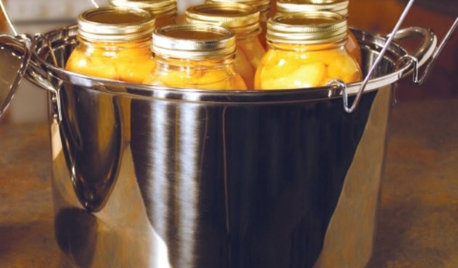Pureeing tomatoes, canning salsa
scwasil
9 years ago
Related Stories

PRODUCT PICKSGuest Picks: Canning, Preserving, Steaming, Dehydrating
20 products to help make fall produce last through the season and beyond
Full Story
LIFEKitchen Traditions: Tomato Season Meets a Family Legacy
Somewhere a Sicilian great-great-grandmother is smiling at a bowl of American-made sauce
Full Story
FARM YOUR YARDHouzz Call: Home Farmers, Show Us Your Edible Gardens
We want to see where your tomatoes, summer squashes and beautiful berries are growing this summer
Full Story
EDIBLE GARDENSHouzz Call: What Did You Grow This Summer?
Let’s celebrate the homegrown fruits and vegetables of the season. Post your pictures and tell us about your harvest
Full Story
GARDENING AND LANDSCAPINGWorld of Design: 10 Home Gardeners Show Us Their Sweet Summer Harvests
From New York to Tokyo, these gardeners have turned their yards, terraces and rooftops into places of bounty
Full Story
FEEL-GOOD HOMESimple Pleasures: Make Do and Mend
Experience the satisfaction of fixing, repurposing and creating things yourself around the home
Full Story
BASEMENTSHouzz TV: Ashton Kutcher Surprises Mom With the Basement of Her Dreams
In a new Houzz original series, the actor uses the Houzz app to find a designer and shop products to turn the dark area into a bright space
Full Story
KITCHEN DESIGNUsing White Marble: Hot Debate Over a Classic Beauty
Do you love perfection or patina? Here's how to see if marble's right for you
Full Story
HEALTHY HOME6 Tips From a Nearly Zero-Waste Home
Lower your trash output and increase your quality of life with these ideas from a mom who did it to the max
Full Story
SUMMER FRUITS AND VEGETABLESSummer Crops: How to Grow Beans
Grow your own beans for amazing variety and healthy, convenient produce all summer
Full Story





digdirt2
lpinkmountain
Related Professionals
New Bedford Landscape Architects & Landscape Designers · Franconia Landscape Architects & Landscape Designers · Ilchester Landscape Architects & Landscape Designers · Leawood Landscape Architects & Landscape Designers · Edmond Landscape Contractors · Surprise Landscape Contractors · Huntington Landscape Contractors · Madera Landscape Contractors · Medford Landscape Contractors · South Farmingdale Landscape Contractors · Stallings Landscape Contractors · Tacoma Landscape Contractors · Rome Roofing & Gutters · Fallbrook Driveway Installation & Maintenance · New Bedford Driveway Installation & MaintenancescwasilOriginal Author
2ajsmama
digdirt2
lpinkmountain